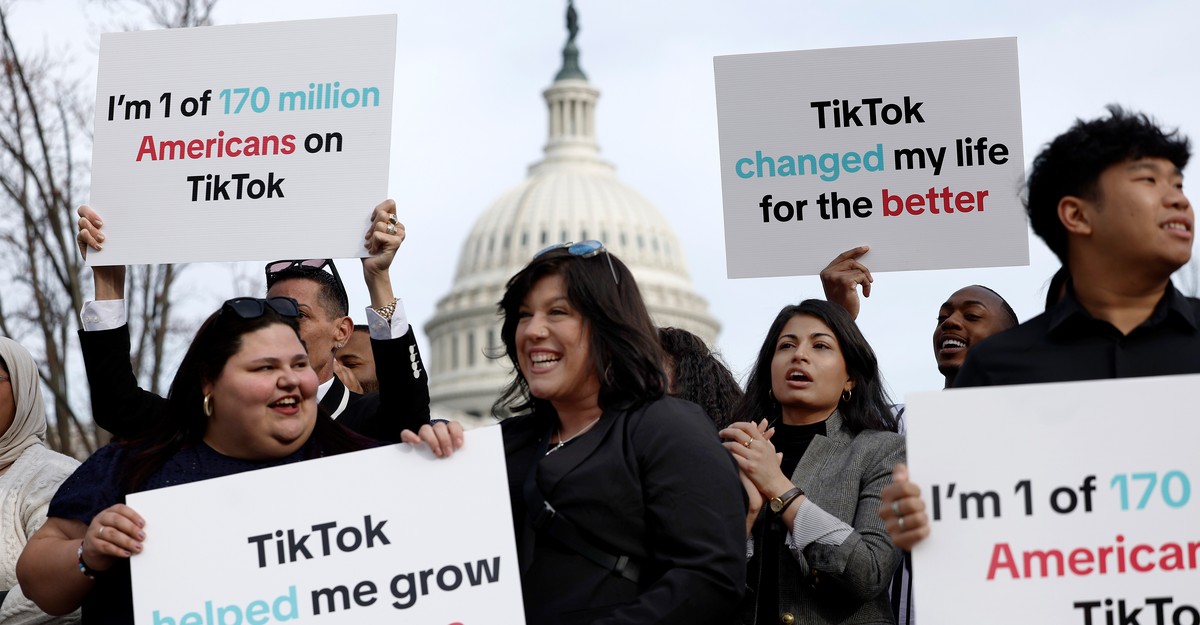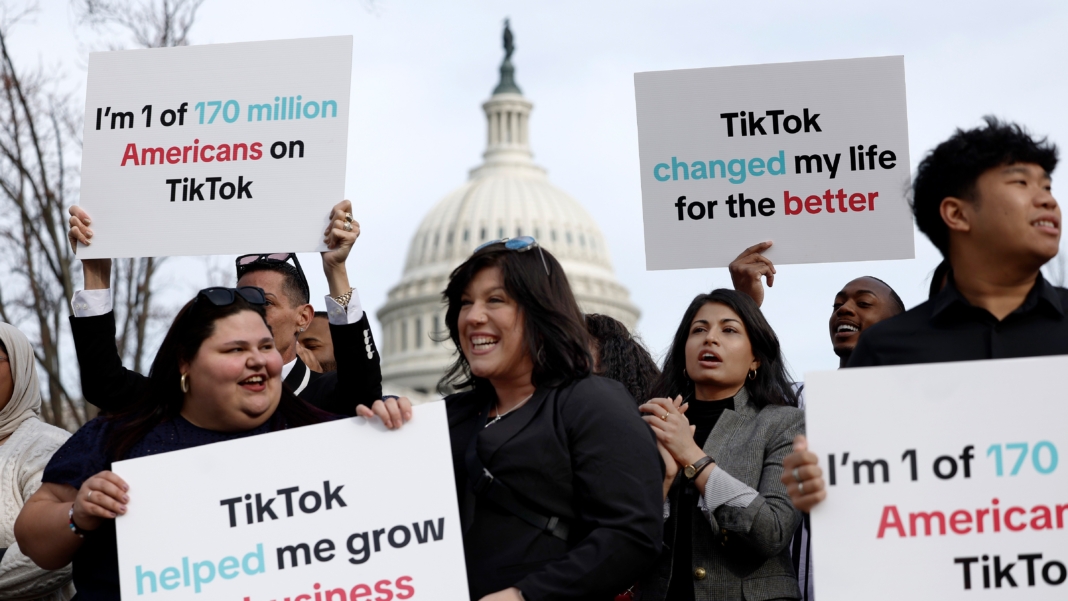
In 2019, I had full-blown app fatigue. My scrolling time was dominated by Instagram and Twitter, my idle hours by YouTube, and on top of that I was still checking Facebook, Snapchat, and whatever buzzy platform my friends were touting that week. (Remember Lasso? Anyone?) There was no room for any more, I told the publicist sitting across from me in a conference room in Anaheim, California. But she was insistent that, as a journalist writing about internet culture, I needed to start paying more attention to the app I knew only peripherally as a place for tween lip-synching and dancing. TikTok, she said, would soon be for everyone.
This promise came true. TikTok is now a social-media juggernaut that has transformed internet culture—and beyond. The app, with its short, audio-heavy videos served in an algorithmic feed, has launched the careers of multiple now-mainstream musicians, including Lil Nas X and Noah Kahan. It’s the reason Stanley cups and Birkenstock clogs were under lots of Christmas trees last year. Everything from Billboard charts to beauty trends to politics itself has bowed to or been transformed by TikTok.
All of that is now under threat. Today, the House of Representatives overwhelmingly voted to force TikTok’s parent company, ByteDance, to divest from the app or face a ban in the United States. (ByteDance was founded by Chinese entrepreneurs, and some American lawmakers are worried it has ties to the Chinese government, which the company denies.) If it passes the Senate—still a big if—President Joe Biden has said he would sign the bill into law, potentially removing one of the most visited social-media apps in the country. But Americans may miss it less than they think.
Sure, TikTok has cultivated a culture and community that no other platform has come close to replicating. There’s a speed to how TikTok facilitates conversations and trends, and its algorithm is unnervingly good at picking up on a user’s interests and showing them what they want to see. You could use the app for just five minutes and come away with a new song to listen to, a new recipe to try for dinner, and a new piece of kitchenware already being packed up and shipped to you. Four years ago, when the coronavirus pandemic sent much of the country into lockdown, users flocked to the app in droves in search of entertainment and connection. The number of people who used the app at least once a month in the United States jumped from 11 million at the start of 2018 to 100 million in less than three years. Today, that number is more than 150 million.
But TikTok is far from America’s favorite social-media app. In a recent Pew survey, a third of adults said they had ever used TikTok—about half the percentage of people who have used Facebook, and slightly less even than Pinterest. Of course, TikTok is much newer than Facebook and Instagram; it’s Gen Z that has been branded the “TikTok generation.” But TikTok is not Zoomers’ favorite app either. In another recent Pew survey, 63 percent of 13-to-17-year-olds said they’re on TikTok—but more are on YouTube, and Snapchat is nearly as popular as TikTok. There are valid reasons to question a potential ban, but users will certainly have options if it comes to pass.
TikTok’s best days in the U.S. may be behind it, anyway. The long-term viability of a social-media app is dependent on its ability to bring in new users, and TikTok’s growth has flatlined. Like Facebook before it, TikTok is beginning to struggle with younger people. Almost 40 percent of the app’s users are now in their 30s and 40s, according to an analysis by the journalist Ryan Broderick. Millennials are its fastest-growing demographic, and they are more likely to actually post something. If this demographic continues to dominate, it’s hard to see how TikTok remains the hub for internet and youth culture.
The app isn’t helping itself. Over the past week, the company has repeatedly sent its users push alerts urging them to call their representatives to express their love of the app, and many did just that—which likely inflamed concerns from politicians that TikTok could be used for propaganda. But there are more fundamental issues as well. Those who are loyal to TikTok will tell you that the good old days are long gone. It went from a plaything for regular people—the dancing tweens, the animal antics—to a stage for brands and creators, and continues to make moves that push itself further from its original premise. It is experimenting with videos up to 15 minutes long, as well as ones filmed horizontally—which sounds a lot more like YouTube than TikTok. Perhaps the biggest change is TikTok Shop, the app’s foray into e-commerce. Users have lamented that the feature is turning the algorithmic “For You” feed into a de facto QVC livestream, with commission-based videos touting cheap and useless goods encouraged to interrupt users’ feeds. And most recently, the app’s music catalog, the backbone of its robust video-trend culture, was slashed after TikTok failed to reach a deal with Universal Music Group.
If TikTok does indeed die, the ban may ultimately feel meaningless for millions of online Americans: YouTube, Instagram, and Snapchat have all responded to the rise of TikTok by creating their own endlessly scrolling, vertical, algorithmically controlled video feeds. When India banned TikTok, in 2020, people simply migrated elsewhere. “I don’t think that anybody has really complained about missing TikTok,” an Indian venture capitalist told Rest of World last year.
The previous time America tried to ban TikTok, in 2020, the “For You” page was flooded with preemptive goodbyes and urgent pleas from creators for their followers to find them elsewhere on the internet. Yet today’s vote is hardly dominating feeds. Perhaps that’s because now, unlike then, TikTok is for everyone—just like so many of the other apps to choose from.
Source: theatlantic.com



